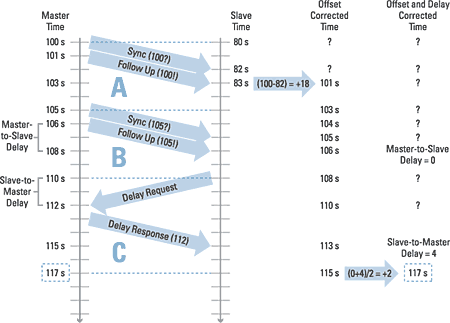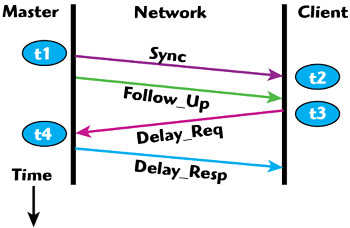Precision Time Protocol
The Precision Time Protocol ( PTP) is a network protocol that causes the synchronicity of the time settings of multiple devices in a computer network. Unlike the Network Time Protocol ( NTP), the focus of PTP is on higher accuracy and localized networks. PTP can achieve in hardware design, an accuracy in the range of nanoseconds, and software version in the range of a few microseconds. PTP is defined in the IEEE 1588 and IEC 61588 has been adopted.
Operation
Network organization
A PTP network consists of communicating watches. These participating devices is determined by the best master clock (BMC ) algorithm that which gives the most accurate time. This device is used as the reference clock and is referred to as the grandmaster clock. When changes in the network topology of the BMC algorithm is performed again to possibly cut off from the Grand Master network segments. If a participating device, both the master and the slave role, then it is referred to as a boundary clock.
Expiration
In operation, each of the master distributes the timing signal to its slaves to determine the so-called delay ( engl. delay). These timestamps (Sync messages) from the reference clock to the slave ship, which determines the time of receipt of timestamps on his own time. In addition, the slave sends repeated a delay request message to the master whose reception time is again sent back as a delay response message to the slave to the master.
For each of the differences between the four time counters, the master -to- slave delay and the slave -to- master delay are determined. In these values, so in each case the difference between the two clocks and the message delay time is included with opposite sign. The mean of the two values thus provides the directional Offset to Master, which is finally used to synchronize its own clock.
The compensation of the running times relies on the assumption that the round trip of synchronization messages have the same average running times and change only slowly with time. The approach of the reference occurs continuously over a control method. In particular, recesses can be avoided as in the slave time.
Types of clocks
The Precision Time Protocol recognizes different types of clocks:
- An ordinary clock (English Ordinary Clock, short OC) is with the role of master either the source or the role of slave receiver of the time, but not both. Simple clocks synchronize directly.
- A ' Boundary Clock' (BC ) is a clock that transports the time information via a network boundary. So, for example, in a router that connects different ' Switched ' networks: As a slave, the clock of the router receives the time information and passes it on as a master.
- A transparent, and transparent clock (English Transparent Clock, short TC) was subsequently added to the specification in 2008 and improved within a network when forwarding time information by receiving the PTP messages and modified (corrected) forwards.
Transmission modes
Supports hardware which sends the frames, the insertion of the exact actual Absendezeitpunkts on-the -fly, ie they can insert this information independently in the frame to be transmitted, the protocol can be operated in the mode ' One Step '. In this case, sufficient, a step, so the sending of only one frame in order to transmit the current-time recipients of the local device. In the other case, the exact actual transmission time will be sent in a second frame, so this mode is called ' Two Step '.
Reactions
The protocol specification envisages to make all timestamps as late as possible before shipping and as early as possible after the receipt of messages. This shows the advantage of hardware support compared to the pure software variant. Time is recorded in the processor of the network device provides significantly more accurate values than by the CPU of the computer.
The available at the current time implementations mostly use Ethernet as the network medium. The protocol specification with respect to the network medium not set.
Implementation in network card: According to the manufacturer's website, there are SolarFlare of a network interface card ( " SFN5322F " ), which implements PTP in hardware.









